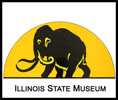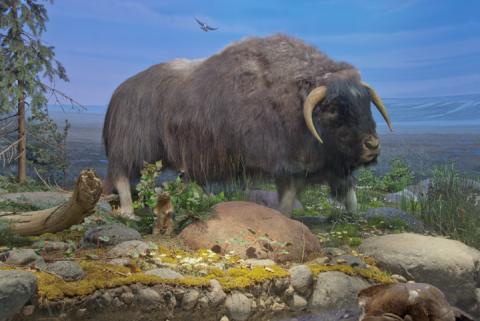Steppe Tundra
Tundra diorama in the Changes exhibit, Illinois State Museum. Vegetation reconstruction based on pollen records from Biggsville (Henderson Co., IL) ~25,000 years ago.
Steppic and forest tundra characterize the landscape at glacial margins, at the height of late Wisconsin glaciation in the Great Lakes region. This late Ice Age "Tundra-like" biome was a relatively open landscape, with fewer trees and more grasses, sedges, and herbaceous vegetation. At a regional scale, there was likley a mosaic of vegetation patches, including tundra, open boreal woodlands, mixed coniferous-deciduous forest, and pine woodlands (Yansa and Adams 2012). In the central and eastern parts of the Midwest, sparse tree cover, characteristic of steppe tundra was probably present only in a narrow band along the glacial front. Western parts of the Midwest and Great Plains were likely more open, with even fewer trees. Annual temperatures were 5 to 10 degrees Celsius less than modern (Jackson et al. 2000).
Animals present in this environment were able to survive severe cold and dry conditions. In the Midwest, these species included large, grazing herbivores like mammoths, caribou, tundra muskoxen, and mylodont sloths. Open-ground predators such as Scimitar cats, American lions, and Short-faced bears would have hunted these large prey. Many megaherbivores performed key ecological functions such as providing needed nutrients in early successional environments (through manure) or grazing mature vegetation to increase biological diversity. When animals perform key ecological roles within an ecosystem, they are called "keystone" species. When keystone species go extinct, those ecological functions are no longer present and the entire ecosystem changes.
Biological communities occupying the Tundra-like landscapes of the Midwest during the last glacial maximum were very adapated to cold and arid environments. However, glaciers and periglacial environments also produce changes in the underlying geology. Features such as ice-walled lakes, pingos, and patterned ground can still be seen on the modern-day surface of glaciated areas.
- Northeastern Illinois: 21,700-16,200 cal BP (Curry and Yansa 2004, Currey et al. 2010)
- Eastern Wisconsin: after 14,500 cal BP (Maher et al. 1998)
- Lower Michigan: ~12,000 cal BP (Larson et al. 1994)




